This post may contain affiliate links. As an Amazon Associate I earn from qualifying purchases at no extra cost to you.
This vegan radish kimchi or Kkakdugi (in Korean) is a spicy, tangy, and salty mixture of fermented radish and a variety of seasonings.
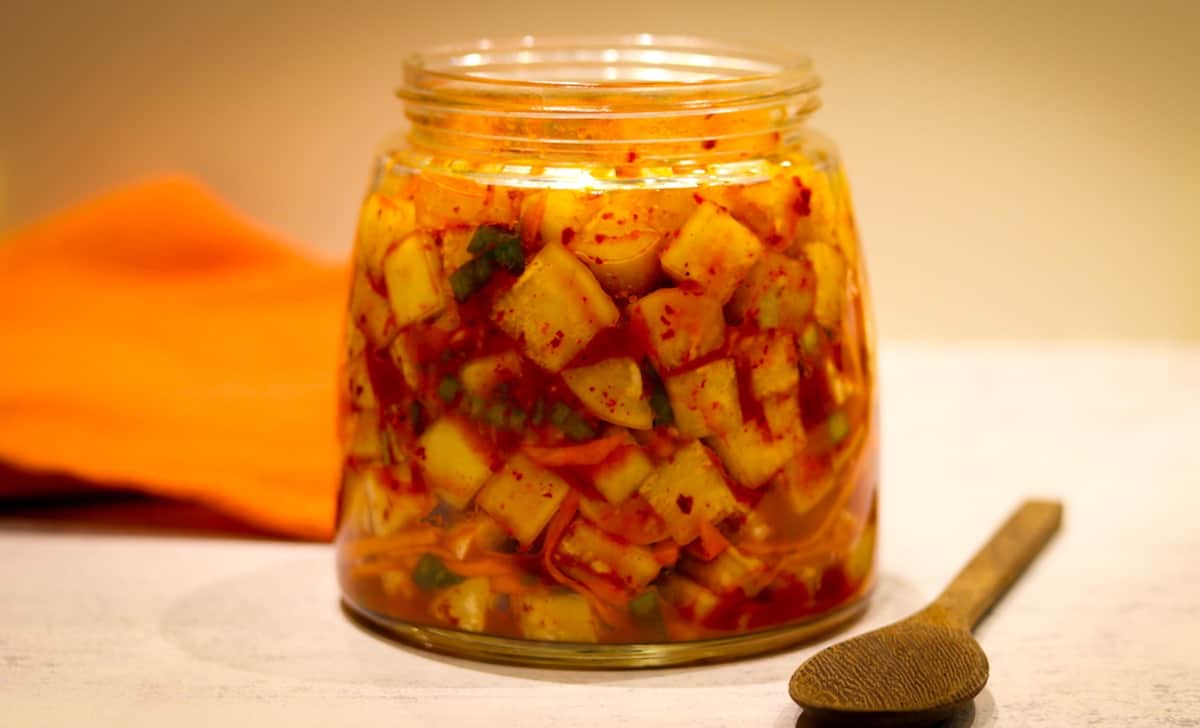
What is kimchi
Kimchi, a staple food in Korean cuisine, is made of fermented and salted vegetables such as napa cabbage, radish, carrots, spring onion, garlic, ginger, and various seasonings.
My love for kimchi
My best friend in London is from Seoul, and her mom makes the best homemade kimchi. She very kindly sends me a jar whenever she makes some. Although I have eaten kimchi in many Korean restaurants across London, there is something magical about homemade kimchi. You can customize the spice level and seasoning according to your liking.
What does the vegan radish kimchi taste like
During fermentation, the lactic acid produced by bacteria creates a tangy, pungent flavour similar to that of sauerkraut. This kimchi is savoury, sour, spicy, and salty and super-delicious. The taste of this kimchi intensifies during fermentation.
It:
is packed with nutrients,
is vegan,
can be made as spicy or as mild as you like,
is packed with probiotic nutrients,
and is excellent for gut health.
How to make it
This recipe requires less than 10 ingredients and less than an hour to make.
You must use clean surfaces, spoons, utensils and hands throughout the preparation of kimchi to prevent the build-up of bad bacteria as it can disrupt the fermentation process.
Start by washing, peeling and cutting the Korean radish into one-inch cubes, and transfer them to a large bowl. To this, add salt, sugar and mix well. Set aside for 30 minutes.
Drain the liquid from the radish to another bowl.
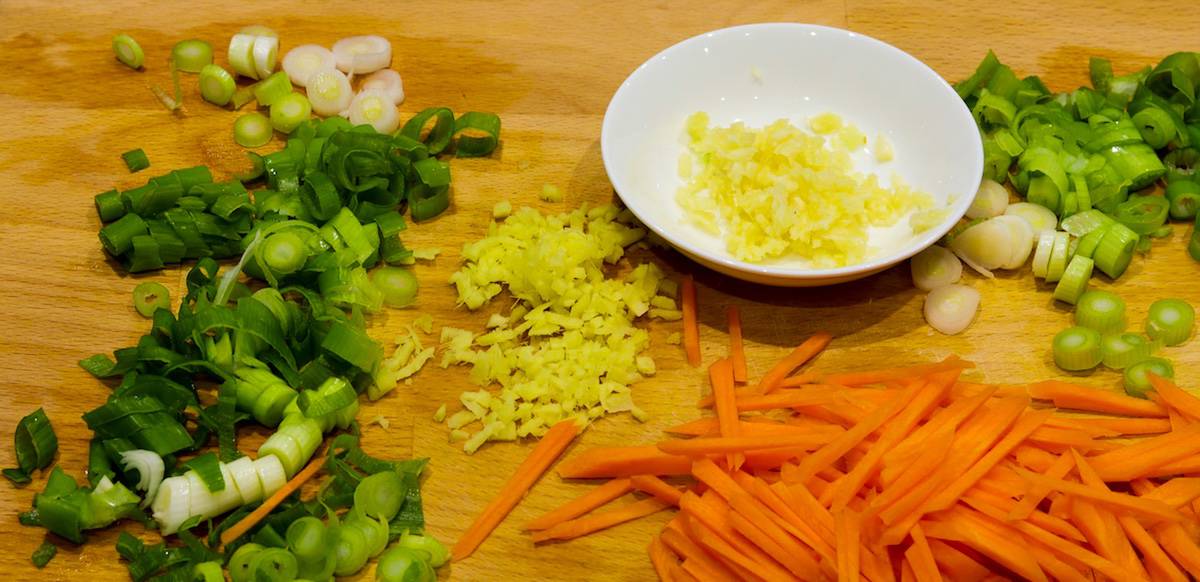
To the large bowl with radish cubes, add sliced carrot, ginger, garlic, spring onions, soy sauce, gochugaru (Korean red chilli pepper flakes) and half the juice from the radish. Use clean hands to mix well to ensure all radish cubes are well coated.
I use the Kimchi with Everything Gochugaru Kimchi Chilli Pepper Flakes. I’ve made multiple batches of kimchi with these and use them regularly in my recipes. I absolutely LOVE the flavour.
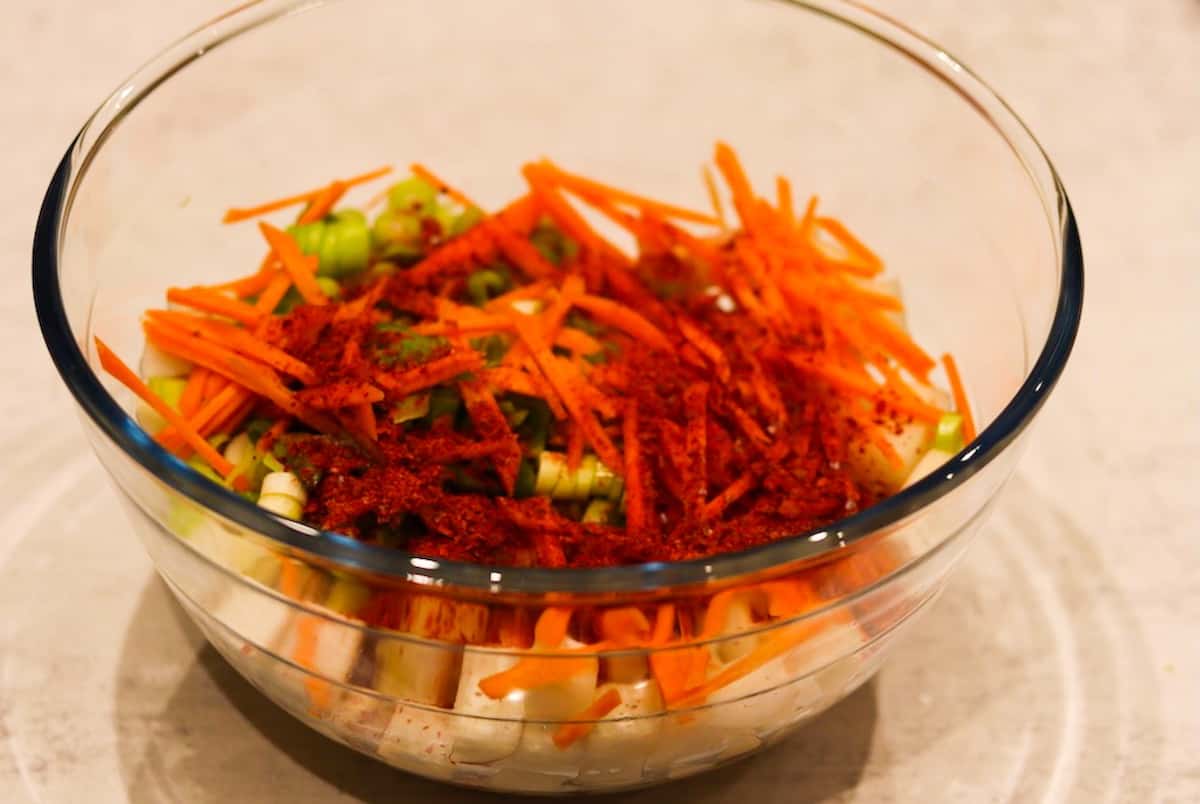
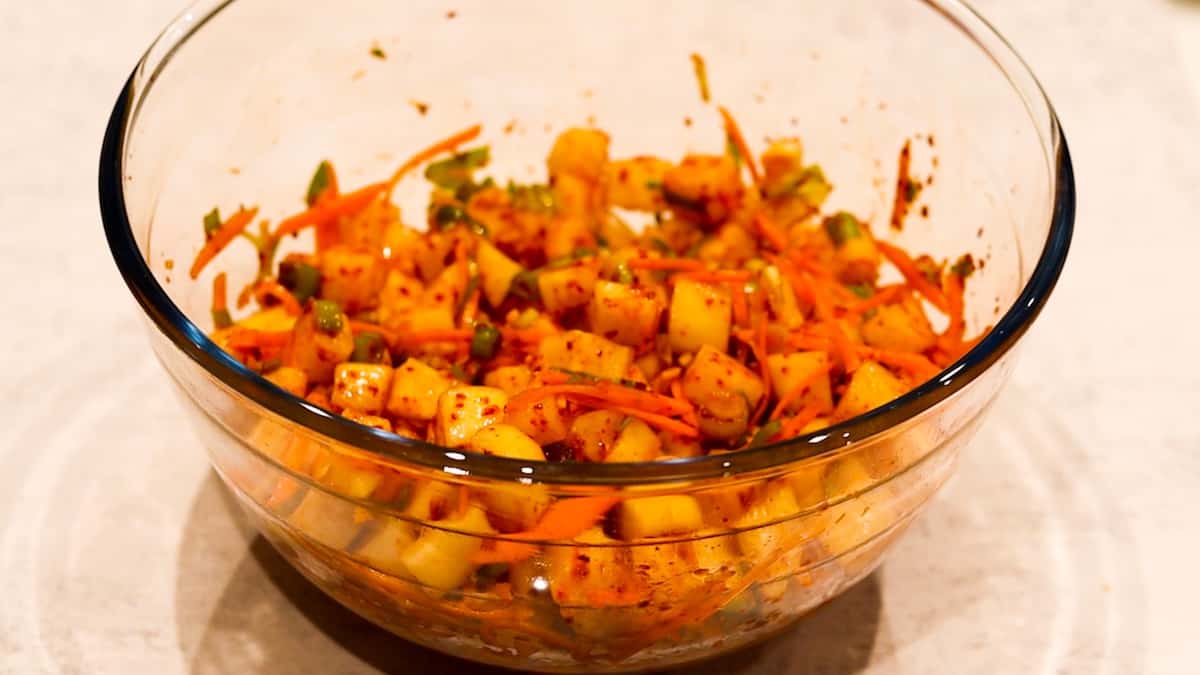
Transfer to a glass jar and press down to release any air bubbles. You can eat the kimchi at this stage or cover the jar with a clean, sterilised lid in a cool dark place to ferment. Fermentation can take anywhere from 36 to 48 hours, or sometimes a day more. Mine took 48 hours.
When fermentation occurs, you will see tiny air bubbles on top of the kimchi and notice a strong and sour smell. That is when you need to transfer the jar to the fridge. Refrigeration slows down the fermentation, which will make the kimchi more sour as time goes on.
Serving instructions
You can eat kimchi as a side dish with your rice bowl, salads, add to stir-fries, bibimbap, soups, sandwiches or even eat it by the spoonful. It is a wonderfully versatile condiment and elevates the taste of the overall dish.
It pairs perfectly with my Mushroom fried rice.
Storage instructions
Kimchi will stay fresh in the fridge for at least a month. If unopened, it will keep in the fridge for months. Any strong, unpleasant smell or formation of mold is an indication that the kimchi had gone bad.
If you try this recipe, please let me know in the comments and don’t forget to leave a rating. I love hearing from you!
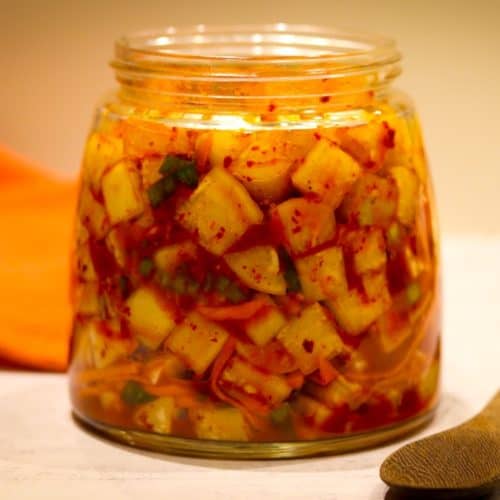
Vegan radish kimchi
Ingredients
- 750 grams Korean radish or daikon
- 1 tablespoon kosher salt
- 1 tablespoon caster sugar
- ⅛ cup soy sauce
- ⅓ cup gochugaru or Korean hot pepper flakes
- 2 stalks of spring onion chopped
- 1 tablespoon garlic minced
- 1 tablespoon ginger minced
- 2 large carrots cut into matchsticks
Instructions
- You must use clean surfaces, spoons, utensils and hands throughout the preparation of kimchi to prevent the build-up of bad bacteria as it can disrupt the fermentation process.
- Start by washing, peeling and cutting the Korean radish into one-inch cubes, and transfer them to a large bowl. To this, add salt, sugar and mix well. Set aside for 30 minutes.
- Drain the liquid from the radish to another bowl.
- To the large bowl with radish cubes, add sliced carrot, ginger, garlic, spring onions, soy sauce, gochugaru (Korean red chilli pepper flakes) and half the juice from the radish. Use clean hands to mix well to ensure all radish cubes are well coated.
- Transfer to a glass jar and press down to release any air bubbles. You can eat the kimchi at this stage or cover the jar with a clean, sterilised lid in a cool dark place to ferment. Fermentation can take anywhere from 36 to 48 hours, or sometimes a day more. Mine took 48 hours.
- When fermentation occurs, you will see tiny air bubbles on top of the kimchi and notice a strong and sour smell. That is when you need to transfer the jar to the fridge. Refrigeration slows down the fermentation, which will make the kimchi more sour as time goes on.
- Kimchi will stay fresh in the fridge for at least a month. If unopened, it will keep in the fridge for months. Any strong, unpleasant smell or formation of mold is an indication that the kimchi had gone bad.
Notes
- Nutrition values are a rough estimate for guidance.
- Take and adjust the level of spice by adding or reducing gochugaru i.e. Korean hot pepper flakes.
- Adapted from Maangchi’s blog. She has an amazing Korean food blog and I love her recipes.


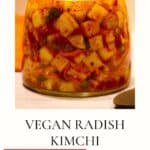
Rita
This is by far the best radish kimchi recipe I came across. Love it so much. Delicious as a side dish x
Vegetarian Globe
Yay! thanks for the lovely feedback, Rita. So happy you liked it.